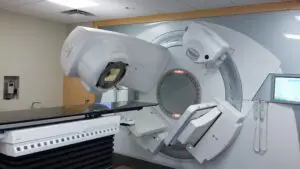Overview
Radiation is the use of high-energy electromagnetic rays to disrupt the DNA that causes cancer. Radiation can kill the cancer cells and/or stop new cells from being created. A radiation oncologist plans and directs radiation treatment in cancer patients, working with a team that may include a radiation oncology nurse, technicians, and therapists.
In some cases, radiation is used in combination with other treatments, such as surgery and/or chemotherapy. For example, radiation may be used to shrink tumors before surgery, or may be used in conjunction with chemotherapy to treat recurring tumors. Radiation can also be used to shrink tumors, make the patient more comfortable, and prolong life when surgery is not possible. Radiation is also sometimes used to treat fibrolamellar metastases outside of the liver1.
Use of radiation therapy in FLC
For cancers like FLC, radiation therapy is typically given in two ways:
For more information about radiation therapy, please visit:
https://www.cancer.net/navigating-cancer-care/how-cancer-treated/radiation-therapy/understanding-radiation-therapy
1 https://www.ncbi.nlm.nih.gov/pmc/articles/PMC3804803/
Please note: The Fibrolamellar Cancer Foundation does not provide medical advice or recommend any specific organizations or services. We provide website users with information to help them better understand their health conditions and current approaches to the diagnosis and treatment of FLC. Always seek the advice of your physician or other qualified healthcare providers.

